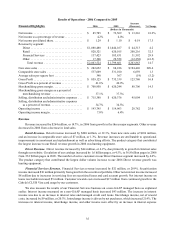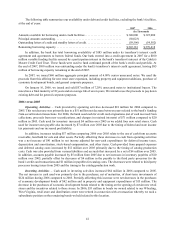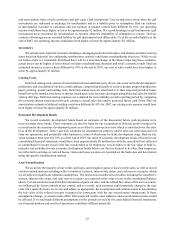Cabela's 2007 Annual Report Download - page 49
Download and view the complete annual report
Please find page 49 of the 2007 Cabela's annual report below. You can navigate through the pages in the report by either clicking on the pages listed below, or by using the keyword search tool below to find specific information within the annual report.43
an independent trustee. Because the trust qualifies as a “qualified special purpose entity” within the meaning of
Statement of Financial Accounting Standards No. 140, Accounting for Transfers and Servicing of Financial Assets
and Extinguishments of Liabilities (“FAS 140”), its assets and liabilities are not consolidated in our balance sheet in
accordance with FAS 140.
The trust issues to outside investors various forms of certificates and notes each of which has an undivided
interest in the assets of the trust. The trust pays to the holders of the certificates and notes a portion of future
scheduled cash flows under preset terms and conditions, the receipt of which is dependent upon cash flows generated
by the underlying performance of the assets of the trust.
We retain a “transferor’s interest” in the securitized loans, which ranks equal with the investor certificates
and notes; an “interest-only strip,” which represent the right to receive excess cash available after repayment of all
amounts to the investors; servicing rights; cash reserve accounts in some cases and Class B securities in one of the
securitizations. Neither the investors nor the trust have recourse against us beyond the assets of the trust, other than
for breaches of certain customary representations, warranties, and covenants and minimum account balance levels
which must be maintained to support our retained interests. These representations, warranties, covenants, and the
related indemnities do not protect the trust or the outside investors against credit-related losses on the loans.
We record our interest-only strips as an asset at fair value, which is an amount equal to the estimated present
value of cash flows to be received by us over the expected outstanding period of the loans. These cash flows essentially
represent finance charges and late fees in excess of the amounts paid to certificate and note holders, credit losses, and
servicing and administration fees. We use certain valuation assumptions related to the average lives of the loans sold
and anticipated credit losses, as well as the appropriate market discount rate, in determining the estimated present
value of the interest-only strips. Changes in the average life of the loans sold, discount rate, and credit-loss percentage
could adversely impact the actual value of the interest-only strips. Accordingly, actual results could differ materially
from the estimates, and changes in circumstances could result in significant future changes to the assumptions
currently being used.
Gains on securitization transactions, fair value adjustments, and earnings on our securitizations are included
in consolidated revenue in the consolidated statement of income, and the cash reserve accounts, Class B securities,
and the interest-only strips are included on our consolidated balance sheet as “retained interests in securitized loans.”
All of the bank’s securitization transactions are currently accounted for as sale transactions. As a result, the loans
relating to those pools of assets are not reflected on our consolidated balance sheet, other than our transferor’s
interest, cash reserve accounts, Class B securities and interest-only strips.
A credit card loan represents a financial asset. Unlike a mortgage or other closed-end loan account, the terms
of a credit card account permit a customer to borrow additional amounts and to repay each month an amount the
customer chooses, subject to a monthly minimum payment requirement. The credit card account remains open after
repayment of the balance and the customer may continue to use it to borrow additional amounts. We reserve the
right to change the credit card account terms, including interest rates and fees, in accordance with the terms of the
credit card agreement and applicable law. The credit card account is, therefore, separate and distinct from the loan.
In a credit card securitization, the credit card account relationships are not sold to the securitization entity. We retain
ownership of the credit card account relationship, including the right to change the terms of the credit card account.
We sell our credit card loans in the ordinary course of business through a commercial paper conduit program
and longer-term fixed and floating rate securitization transactions. In a conduit securitization, our credit card loans
are converted into securities and sold to commercial paper issuers, which pool the securities with those of other
issuers. The amount securitized in a conduit structure is allowed to fluctuate within the terms of the facility, which
may provide greater flexibility for liquidity needs.
























